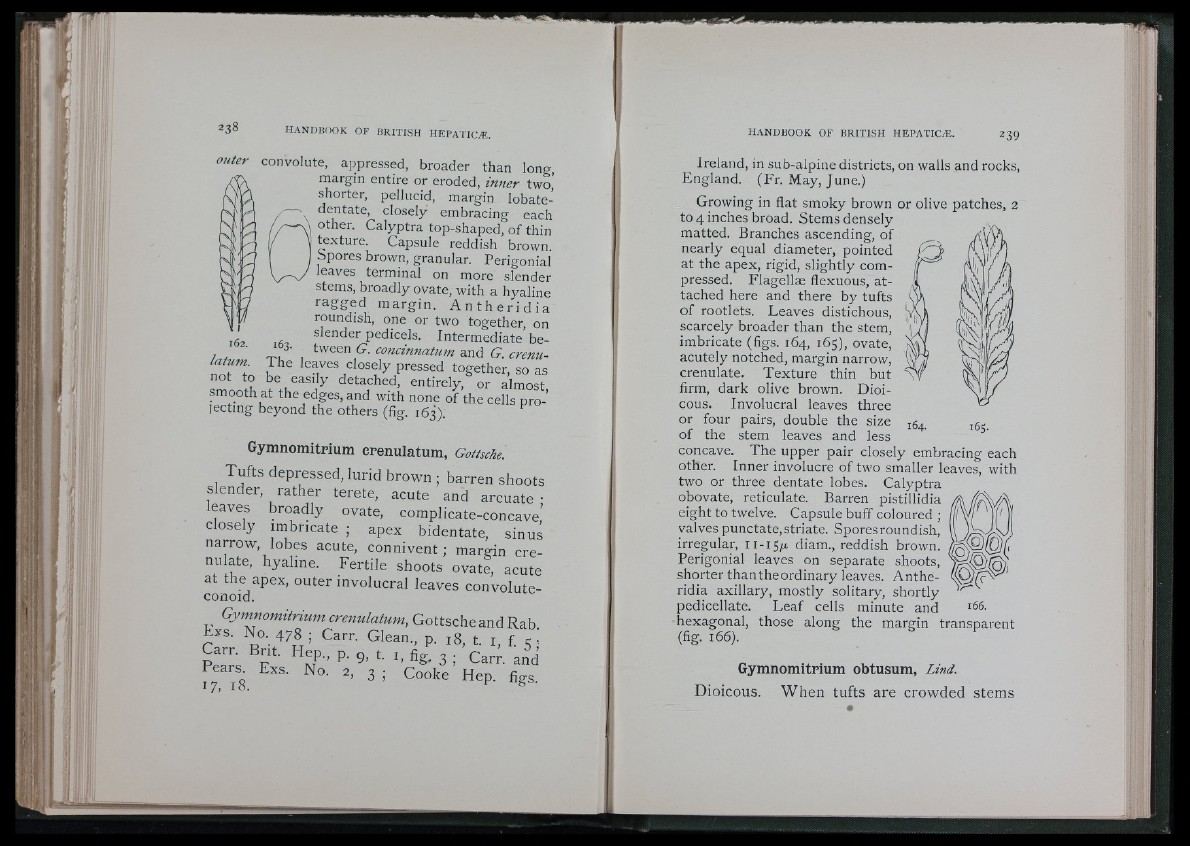
outer
162.
latum.
not to
smooth
jecting
convolute, appressed, broader than long,
margin entire or eroded, inner two,’
shorter, pellucid, margin lobate-’
dentate, closely embracing each
other. Calyptra top-shaped, of thin
texture. Capsule reddish brown.
Spores brown, granular. Perigonial
leaves terminal on more slender
stems, broadly ovate, with a hyaline
r a g g e d ma rg in . A n t h e r i d i a
roundish, one or two together, on
slender pedicels. Intermediate be-
3- tween G. eoneinnatum and G. crenu-
Ihe leaves closely pressed together, so as
be easily detached, entirely, or almost
at the edges, and with none of the cells pro-’
beyond the others (fig. 163)
Gymnomitpium erenulatum, Gottsche.
Tu f t s depressed, lurid brown ; barren shoots
slender, rather terete, acute and arcuate •
leaves broadly ovate, complicate-concave’
c losely imbricate ; apex bidentate, sinu^
narrow, lobes acute, connivent ; margin c renulate,
hyaline. Fert ile shoots ovate, acute
at the apex, outer involucral leaves convolute-
conoid.
Gymnomitrium erenulatum, Got tsche and R ab
Fxs . No. 478 ; Carr. Glean., p. 18 t. i f c -
Pears^ Exs. No. 2, 3 ; Co o ke Hep. % s .
Ireland, in sub-alpine districts, on walls and rocks,
England. (Fr. May, June.)
Growing in flat smoky brown or olive patches, 2
to 4 inches broad. Stems densely
matted. Branches ascending, of
nearly equal diameter, pointed
at the apex, rigid, slightly compressed.
Flagellie flexuous, attached
here and there by tufts
of rootlets. Leaves distichous,
scarcely broader than the stem,
imbricate (figs. 164, 165), ovate,
acutely notched, margin narrow,
crenulate. Texture thin but
firm, dark olive brown. Dioicous.
Involucral leaves three
or four pairs, double the size
164. of the stem leaves and less
165.
concave. The upper pair closely embracing each
other. Inner involucre of two smaller leaves, with
two or three dentate lobes. Calyptra
obovate, reticulate. Barren pistillidia
eight to twelve. Capsule buff coloured ;
valves punctate,striate. Spores roundish,
irregular, ii-15/i diam., reddish brown.
Perigonial leaves on separate shoots,
shorter than the ordinary leaves. Antheridia
axillary, mostly solitary, shortly
jedicellate. Le a f cells minute and
166.
Hexagonal, those along the margin transparent
(fig. 166).
Gymnomitpium obtusum, Lind.
Dioicous. Wh en tufts are c rowded stems